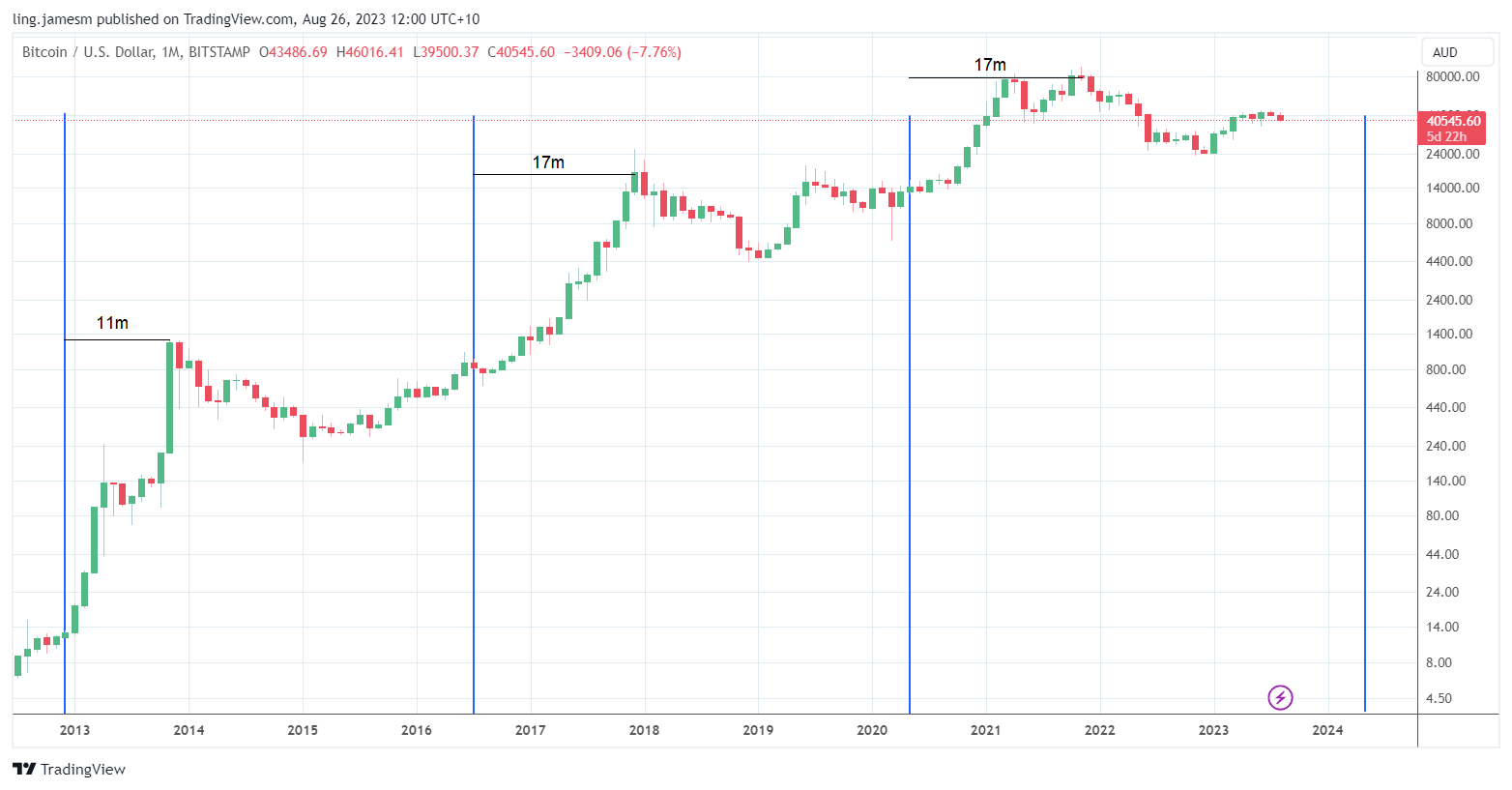Bitcoin and Cycle-nomics
As the crypto granddaddy, Bitcoin’s price behaviour is a bellwether for the entire crypto market and a fascinating mirror for market fear and greed in its own right. Crypto observers will be well aware of Bitcoin’s historical cyclic pattern, while experienced investors will likely remember the sage advice often attributed to Mark Twain that “history doesn’t repeat, but it often rhymes”!
In Bitcoin’s case, its historical price behaviour is a remarkable demonstration of “cycle-nomics” in action, believed by many to be linked to Bitcoin’s “halving” in which the Bitcoin network’s ongoing supply is cut in half every 210,000 blocks produced.
With seven months to go until the next halving, the phrase is bound to more frequently crop up in all discussions of BTC and canny investors should be prepared for the next cycle – and what effect it may have on the price.
First Halving
The first Bitcoin halving in 2012 resulted in the reward for mining a block reducing from 50 to 25 BTC. The next in 2016 reduced the mining incentive from 25 to 12.5 BTC for each block mined, and since May 2020, each new block mined generates 6.25 new BTC.
The next Bitcoin halving to 3.125 BTC per block is expected to take place in April 2024, and the network will continue to generate the mining block reward until roughly 2140 when all Bitcoin is mined. There will never be more than 21 million BTC in circulation.
Bitcoin miner revenue comes from their share of the block reward, and since input costs like electricity, data, staff etc. dictate their break-even point, the halving is widely believed to influence Bitcoin’s market price because a reduction in the mining incentive means that the price must increase to ensure that those input costs can be covered.
This is illustrated here with the halving dates shown and the months to the cycle high (the price on the right-hand scale is logarithmic reinforcing the magnitude of the price increase):

Each cycle to date has demonstrated a repeating pattern:
- A rising market leading into or from the halving from the bottom of the previous cycle.
- An accelerating price leading to a new market high.
- A decline into a long stabilising period (albeit the last two cycles have experienced a “double-top” before the long decline).
The cycle high has occurred between 12-18 months from the halving, being between a quarter and third of the way through the halving cycle. And the cycle tops and bottoms have always exceeded the prior cycle tops and bottoms.
A fascinating aspect of Bitcoin cycles is the effect that the halving has on how miners manage the BTC they earn throughout the cycle.
- As BTC’s price rises, miners may elect to hold onto their Bitcoin earned through mining to capitalise on a rising price rather than selling it immediately. This removes BTC from exchanges and limits the available stock of BTC for sale. This helps to drive up the price.
- As BTC price falls, the opposite happens with miners increasingly selling to meet expenses which increases selling pressure.
- If BTC falls too much, miners with insufficient financial strength to ride out the hard times may turn off their machines (to stem the loss of electricity and other operating costs). This causes the Bitcoin “hash” rate to fall (due to the loss of computing power across the Bitcoin network).
- Falling hash rate lowers the mining “difficulty” which is baked into Bitcoin’s protocol to vary with the amount of hash rate available. A lower difficulty means that it’s easier to mine Bitcoin to earn the same block reward, which then attracts miners to secure the network to earn that block reward. This keeps the network in equilibrium.
- The halving cycle is therefore deflationary because it reduces new supply over time (and therefore increases scarcity).
The cycle obviously depends on increasing demand, but the demand “pull” through the halving cycle has been consistent throughout Bitcoin’s existence to date. And since supply is based on a fixed and predictable schedule, increasing demand must lead to higher price. The investment case for Bitcoin relies entirely upon ongoing demand.
Bitcoin versus Internet adoption is often used to illustrate how much growth potential exists (with likely consequential growth of other digital assets with valuable use cases). The following illustration shows Bitcoin’s faster adoption curve and therefore its potential given the relatively low percentage of world population that uses Bitcoin at this point in its lifecycle (14 years as of writing):

Bitcoin’s halving cycle is an intriguing feature of the protocol designed by Satashi Nakamoto and has so far manifested itself in BTC’s price behaviour over the last three cycles. With seven months to go until the next halving, smart investors should familiarise and prepare for the transition to the next cycle. History may not repeat, but a rhyme might see BTC price hit new all-time-highs within 12-18 months of the halving.
Frequently Asked Questions about this Article…
Bitcoin's halving is an event that occurs approximately every four years, where the reward for mining a block is cut in half. This reduction in supply is believed to influence Bitcoin's price, as miners need higher prices to cover their costs. Historically, Bitcoin's price has risen leading up to and following a halving event.
Bitcoin's halving occurs approximately every four years, or every 210,000 blocks. The next halving is expected to take place in April 2024, reducing the block reward from 6.25 BTC to 3.125 BTC.
Bitcoin miners may choose to hold onto their BTC during price rises to capitalize on potential future gains. By holding rather than selling immediately, they reduce the available supply on exchanges, which can help drive up the price further.
When Bitcoin's price falls, miners may sell more of their BTC to cover expenses, increasing selling pressure. If the price falls too much, some miners may turn off their machines to avoid losses, which can lower the network's hash rate and mining difficulty.
Bitcoin's adoption is often compared to the Internet's growth, with Bitcoin showing a faster adoption curve. This suggests significant growth potential, especially given the relatively low percentage of the world population currently using Bitcoin.
















